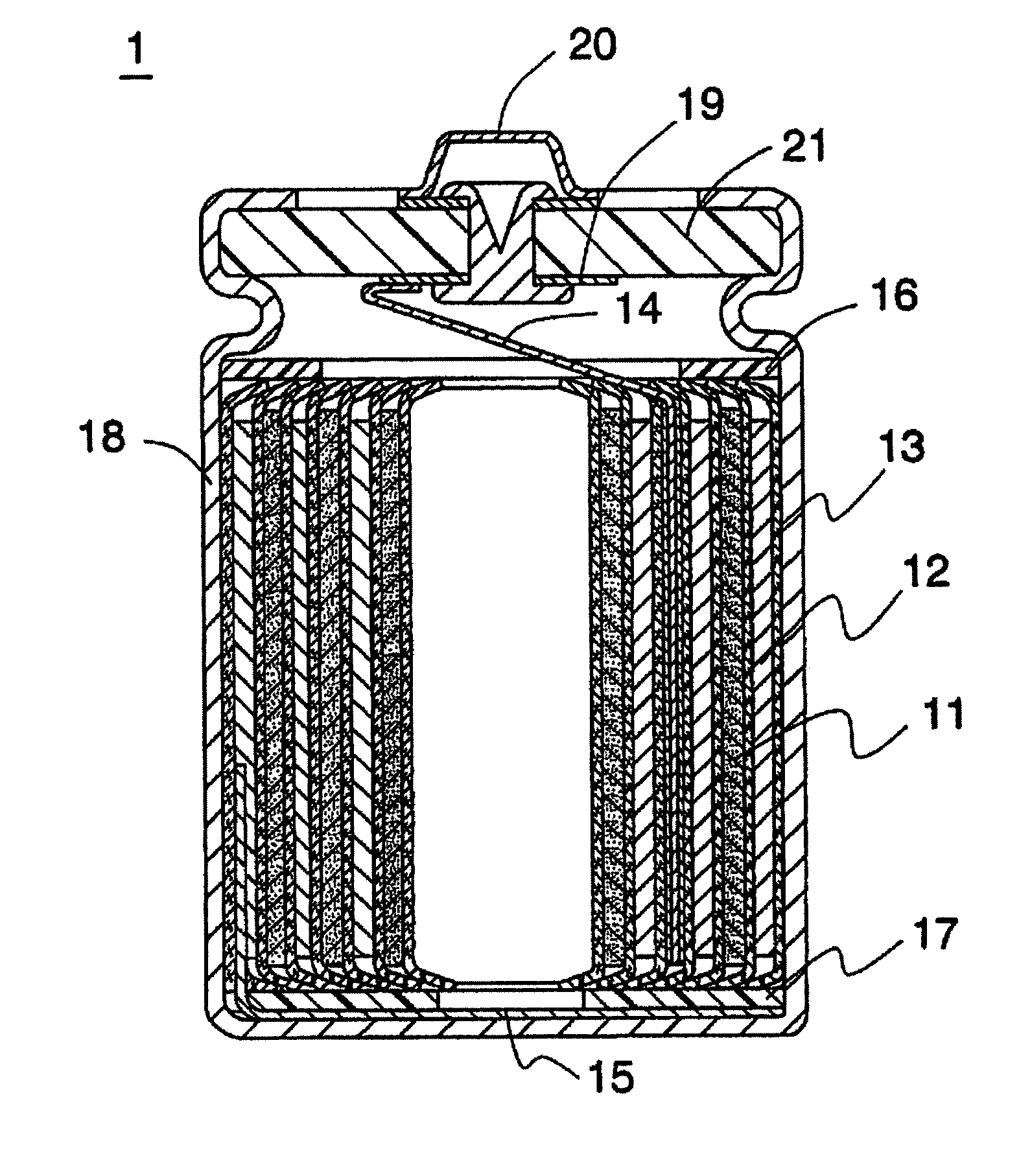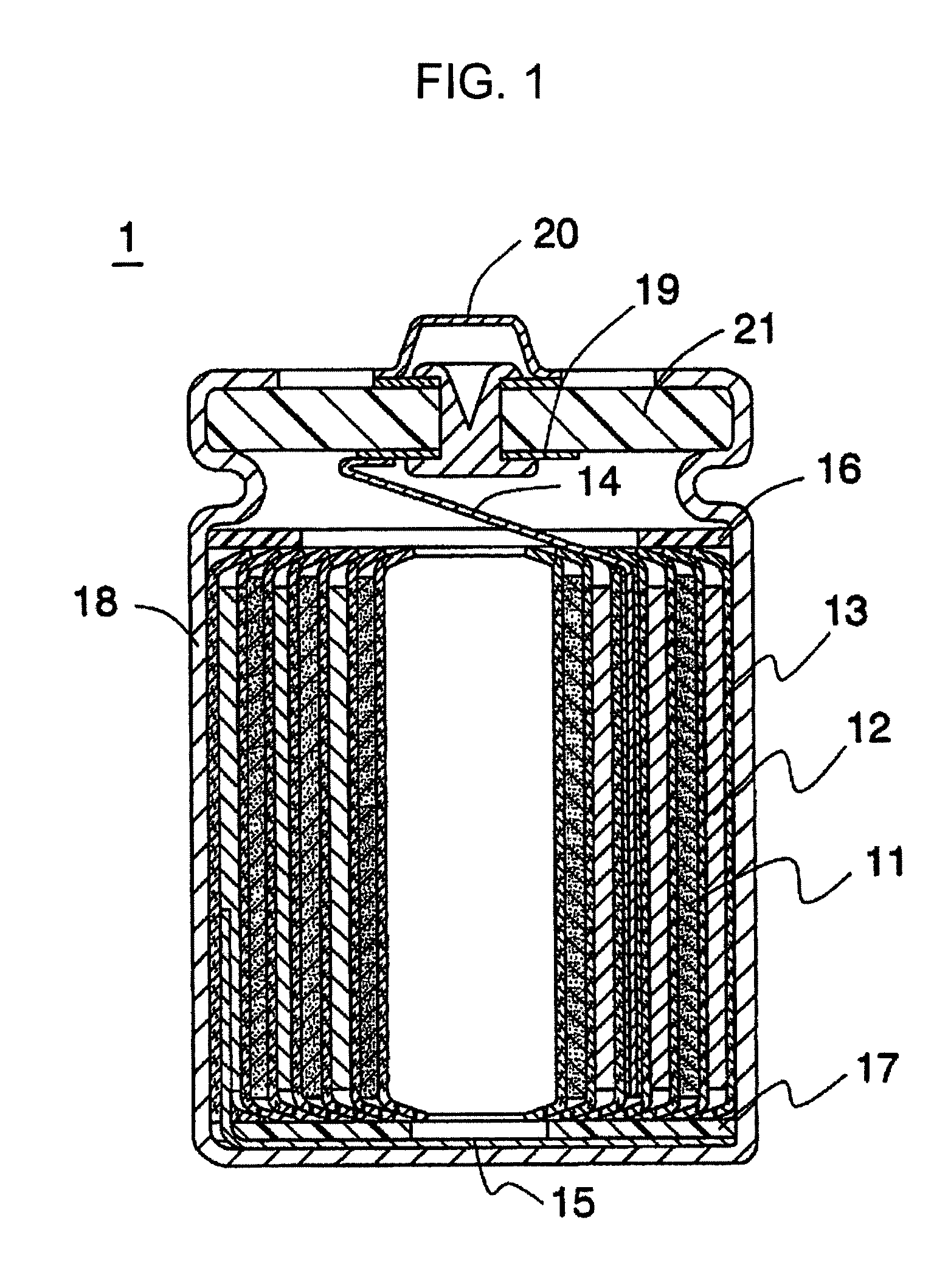Nonaqueous solvent, and nonaqueous electrolyte solution and nonaqueous secondary battery that use nonaqueous solvent
a secondary battery and nonaqueous electrolyte technology, applied in the direction of non-aqueous electrolyte cells, cell components, electrochemical generators, etc., can solve the problems of insufficient control of more difficult to synthesize and therefore more expensive than ordinary organic solvents, etc., to achieve suppressed gas production in the battery and good cycle characteristics
- Summary
- Abstract
- Description
- Claims
- Application Information
AI Technical Summary
Benefits of technology
Problems solved by technology
Method used
Image
Examples
example 1
Investigation of Gas Generation During High-Temperature Storage using Various Fluorinated Cyclic Carbonates
[0085](1) Preparation of Test Electrode
[0086]98 parts by weight of artificial graphite powder (Hitachi Chemical) was mixed with 1 part by weight of modified styrene-butadiene latex (binder) and 1 part by weight of carboxymethyl cellulose (viscosity improver). The resulting mixture was dispersed in water to prepare a mixture slurry. This mixture slurry was coated on the surface of a 10 μm-thick copper foil, and dried and rolled to form a 70 μm-thick active material layer on the copper foil surface and obtain an active material sheet. This active material sheet was cut out into a 35 mm×35 mm size, and ultrasound welded to a copper plate with a lead to prepare a test electrode.
[0087](2) Preparation of Counter Electrode
[0088]300 μm-thick lithium foil was crimped to a 35 mm×35 mm copper plate with a welded lead to prepare a counter electrode.
[0089](3) Preparation of Nonaqueous Elect...
example 2
Investigation of Gas Production During High-Temperature Storage using Various Fluorinated Cyclic Phosphazenes
[0104](1) Preparation of Fluorinated Cyclic Phosphazenes
[0105]The hexamethoxy cyclotriphosphazene (b0) represented by Formula (IX) above was prepared, along with fluoro-pentamethoxy cyclotriphosphazene (b1), difluoro-tetramethoxy cyclotriphosphazene (b2), trifluoro-trimethoxy cyclotriphosphazene (b3), tetrafluoro-dimethoxy cyclotriphosphazene (B4) and pentafluoro-methoxy cyclotriphosphazene (B5), in which 1 to 5 methoxy groups in the b0 molecule were respectively replaced with 1 to 5 fluorine atoms. The trifluoro compound is a mixture of a compound having two F atoms bound to one P atom and one F atom bound to the other P atom with a compound having one F atom bound to each of three P atoms. The tetrafluoro compound is a mixture of a compound having two F atoms bound to one P atom and two F atoms bound to the other P atom with a compound having two F atoms bound to one P atom...
example 3
Investigation of Gas Production During High-Temperature Storage using Various Fluorinated Chain Phosphazenes
[0115](1) Preparation of Fluorinated Chain Phosphazenes
[0116]The fluorinated chain phosphazene represented by Formula (X) below was prepared. The phosphazenes with n values of 1 through 10 (corresponding to m=2 through 11 in the fluorinated phosphazene represented by Formula (III)) were prepared.
[0117]The n=1 (m=2) fluorinated chain phosphazene was called C1, the n=2 (m=3) fluorinated chain phosphazene C2, the n=4 (m=5) fluorinated chain phosphazene C3, the n=6 (m=7) fluorinated chain phosphazene C4, the n=8 (m=9) fluorinated chain phosphazene C5, and the n=10 (m=11) fluorinated chain phosphazene c1.
[0118](2) Preparation of Nonaqueous Solvents
[0119]One was selected from the fluorinated chain phosphazenes C1 through C5 and the fluorinated chain phosphazene c1 prepared above. DMC, the fluorinated cyclic carbonate represented by Formula (V) (H in Table 1) and the selected fluorin...
PUM
 Login to View More
Login to View More Abstract
Description
Claims
Application Information
 Login to View More
Login to View More - R&D
- Intellectual Property
- Life Sciences
- Materials
- Tech Scout
- Unparalleled Data Quality
- Higher Quality Content
- 60% Fewer Hallucinations
Browse by: Latest US Patents, China's latest patents, Technical Efficacy Thesaurus, Application Domain, Technology Topic, Popular Technical Reports.
© 2025 PatSnap. All rights reserved.Legal|Privacy policy|Modern Slavery Act Transparency Statement|Sitemap|About US| Contact US: help@patsnap.com



